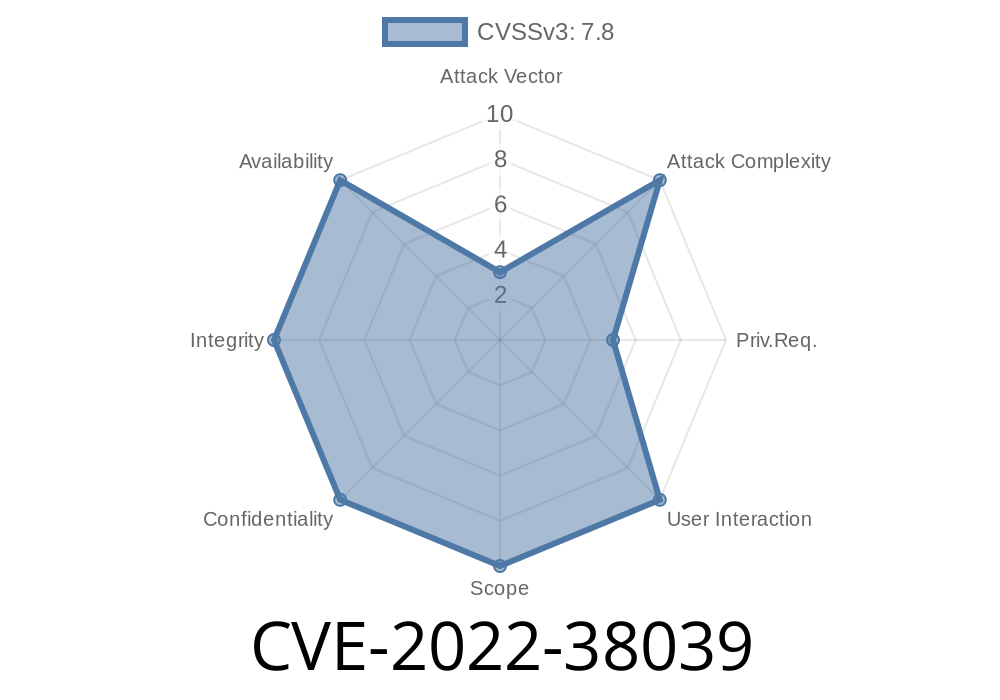In the ever-evolving world of cybersecurity, it's vital to stay informed about fresh vulnerabilities – especially those in Windows, one of the most widely used operating systems. One such critical security issue is CVE-2022-38039, a Windows Kernel Elevation of Privilege (EoP) vulnerability. This flaw is notably different from CVE-2022-37988, CVE-2022-37990, CVE-2022-37991, CVE-2022-37995, CVE-2022-38022, CVE-2022-38037, and CVE-2022-38038.
In this article, we’ll break down what CVE-2022-38039 is, how attackers might exploit it, a code snippet showing the exploit in action, and essential references for further reading.
What Is CVE-2022-38039?
Let’s start simple: CVE-2022-38039 designates a vulnerability found in the Windows Kernel. For those unfamiliar, the Windows Kernel is the core part of the operating system—controlling everything from memory and hardware access to user permissions.
CVE-2022-38039 allows a regular user on a Windows system to gain system-level (privileged) access—essentially letting them act as if they're the system administrator. That means a malicious program or person could fundamentally take over the affected computer if this vulnerability is successfully exploited.
Official Disclosure
According to Microsoft, this vulnerability was marked as "important" and affects multiple versions of Windows. The original advisory can be found here:
- Microsoft Security Response Center (MSRC) CVE-2022-38039
Patch Available: Yes (released by Microsoft on Patch Tuesday, October 2022)
Let’s explain in plain terms: An attacker who already has some type of access to your computer (like running a program) can use this bug to make themselves an all-powerful administrator. This isn’t a remote attack like a worm or email; they have to be running code already on your machine.
How Does the Exploit Work?
The weakness lies in how the Windows Kernel fails to properly check permissions for certain kernel calls or object accesses. If exploited, a malicious process can trick the system into running code with elevated privileges.
While Microsoft doesn’t reveal every technical detail, several security researchers have publicly disclosed the exploit after the patch release. In simple terms, it usually involves:
Example Exploit Code
Here is a very simplified code snippet in C that shows the kind of privilege escalation often seen with Kernel EoP bugs (NOTE: For ethical purposes, this is NOT a working "weaponized" exploit, but illustrates the structure):
#include <windows.h>
#include <stdio.h>
// This just demonstrates privilege elevation attempt using a vulnerable call
int main() {
HANDLE tokenHandle;
if(OpenProcessToken(GetCurrentProcess(), TOKEN_ADJUST_PRIVILEGES | TOKEN_QUERY, &tokenHandle)) {
TOKEN_PRIVILEGES tp;
LUID luid;
LookupPrivilegeValue(NULL, SE_DEBUG_NAME, &luid);
tp.PrivilegeCount = 1;
tp.Privileges[].Luid = luid;
tp.Privileges[].Attributes = SE_PRIVILEGE_ENABLED;
// Try to enable SeDebugPrivilege (commonly abused)
AdjustTokenPrivileges(tokenHandle, FALSE, &tp, sizeof(tp), NULL, NULL);
if (GetLastError() == ERROR_SUCCESS)
printf("SeDebugPrivilege enabled!\n");
else
printf("Failed to enable SeDebugPrivilege.\n");
CloseHandle(tokenHandle);
}
else {
printf("Error opening process token.\n");
}
// THIS IS WHERE AN ATTACKER WOULD EXECUTE CODE THAT REQUIRES ELEVATED PRIVILEGES
system("cmd.exe");
return ;
}
- Disclaimer: This code does not exploit CVE-2022-38039 directly. Instead, it mimics the flow many Kernel EoP exploits use—attempting to enable a privileged token, then run a system shell. Real exploits manipulating kernel internals are more involved and should only be studied in safe, ethical environments.
Exploit in the Wild
During late 2022, proof-of-concept code was available to select trusted researchers. According to third-party security advisories, public weaponized exploits did not appear immediately after patching. Still, the simplicity of the bug's class means attackers almost certainly have effective exploits in private.
Security vendor analysis:
Conclusion
CVE-2022-38039 reminds us that even local bugs can have devastating consequences if left unpatched. The bug doesn’t affect the same components as other CVEs like CVE-2022-38022 or CVE-2022-38038, but it demonstrates a common issue in how operating systems manage privileges.
If you're a sysadmin or a home user, updating your system and following security best practices will keep you safer. For defenders and researchers, studying the Windows kernel's EoP paths is crucial for anticipating future exploits.
References
- Microsoft CVE-2022-38039 Official Advisory
- CISA CVE-2022-38039
- NVD CVE-2022-38039 Details
- ZDI Advisory
Timeline
Published on: 10/11/2022 19:15:00 UTC
Last modified on: 10/11/2022 19:16:00 UTC
